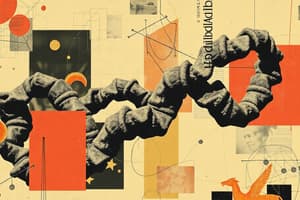Podcast
Questions and Answers
What is the characteristic of the peptide bond responsible for the rigidity of the peptide chain?
What is the characteristic of the peptide bond responsible for the rigidity of the peptide chain?
- Planarity
- Partial double-bond character (correct)
- Hydrolysis of high-energy phosphate bonds
- Resonance nature
Which of the following does NOT denature proteins?
Which of the following does NOT denature proteins?
- Peptide bond formation (correct)
- Prolonged exposure to a strong acid or base at elevated temperatures
- High concentrations of urea
- Heating
What determines the final three-dimensional form adopted by the protein in its native state?
What determines the final three-dimensional form adopted by the protein in its native state?
- Tertiary structure
- Secondary structure
- Primary structure (correct)
- Quaternary structure
What is the process by which peptide bonds are formed?
What is the process by which peptide bonds are formed?
What is the term for the linear sequence of amino acids joined together by peptide bonds?
What is the term for the linear sequence of amino acids joined together by peptide bonds?
What is the characteristic of peptide bonds that allows for rotation within allowed torsion angles?
What is the characteristic of peptide bonds that allows for rotation within allowed torsion angles?
What is the direction in which peptide sequences are written?
What is the direction in which peptide sequences are written?
What is the energy requirement for peptide bond formation?
What is the energy requirement for peptide bond formation?
What is the characteristic of peptide bonds that makes them resistant to denaturation by heat or high concentrations of urea?
What is the characteristic of peptide bonds that makes them resistant to denaturation by heat or high concentrations of urea?
What is the term for the unique three-dimensional structure of a protein in its native state?
What is the term for the unique three-dimensional structure of a protein in its native state?
Flashcards are hidden until you start studying
Study Notes
Proteins
- Proteins are unique in their conformation, which is a consequence of their three-dimensional structural shape.
- Physiological activity is linked to their three-dimensional structure.
- Denaturation (change or alteration of their three-dimensional structure due to extreme temp., changes in pH, or variation in salt concentration) leads to a reduction or loss of biological activity.
Disease States
- Disease states are often related to altered function of a protein.
- Altered function is related to an anomaly in the protein structure.
- Examples of blood disorders and diseases that affect RBC include hemoglobinopathies, sickle cell anemia, and thalassemia (hemolytic anemia due to insufficient production of α or β subunits of hemoglobin).
Amino Acids
- Amino acids are the fundamental units of proteins.
- Amino acids are composed of a carboxyl (-COOH) group, an amino group (NH2), an H atom, and a variable group or side chain (R) all bonded to a carbon atom (α-carbon).
- With the exception of glycine, all amino acids contain at least one asymmetric carbon atom and are therefore optically active.
- Asymmetric carbon atoms are bonded to four different atoms or groups of atoms.
Stereoisomers
- Amino acids exist as stereoisomeric pairs called enantiomers – L (levorotatory) or D (dextrorotatory) amino acid depending on the direction they rotate plane-polarized light.
- Levorotatory (-) describes a chemical compound that rotates the plane of polarization of a transmitted beam of plane-polarized light or other electromagnetic radiation to the left.
Protein Structure
- Proteins are linear, unbranched polymers constructed from 20 different alpha amino acids, encoded in the DNA of the genome.
- Proteins vary in size, with a typical mass of a single chain of proteins ranging from 10-50 kdal.
- Multichain protein complexes can have a mass greater than 200 kdal.
- Proteins make up 50% of the dry weight of cells and are involved in most activities of the organism.
Functions of Proteins
- Enzymatic catalysis: most proteins are enzymes.
- Transport and storage of small molecules and ions (e.g., hemoglobin and lipoproteins).
- Structural elements of the cytoskeleton, providing strength and structure to cells and forming the fundamental mechanistic components of intracellular and extracellular movement.
- Structure of skin and bone (e.g., collagen, keratin).
- Immunity: proteins like antibodies that mediate protective responses to pathogens.
- Hormonal regulation: some hormones are proteins (e.g., somatotropin or pituitary growth hormone and insulin), and cellular receptors that recognize hormones and neurotransmitters are proteins.
- Control of genetic expression.
Peptide Bond
- A peptide bond is a bond formed between the α–carboxyl group of one amino acid and the α –amino group of another, with water being removed in the process.
- Peptide bond formation is highly endergonic (energy-requiring) and requires hydrolysis of high-energy phosphate bonds.
Characteristics of Peptide Bond
- Peptide bonds are planar, with two adjacent α–carbons, a carbonyl oxygen, α–amino nitrogen, and its associated hydrogen atom, and the carbonyl carbon all lying in the same plane.
- Rotations within allowed torsion angles can occur around the bonds attached to the α-carbon, but rotation is prevented around the bond axis due to the partial double-bond character of the C-N.
- Peptide bonds are not broken by conditions that denature proteins, such as heating or high concentrations of urea.
- Peptide bonds can be hydrolyzed by prolonged exposure to a strong acid or base at elevated temperatures.
Conformation of Proteins
- A protein in its native state has a unique three-dimensional structure (conformation).
- Primary structure refers to the linear sequence of amino acids joined together by peptide bonds, which forms the covalent “backbone” of the polypeptide.
- The primary structure is coded for by DNA and determines the final three-dimensional form adopted by the protein in its native state.
Studying That Suits You
Use AI to generate personalized quizzes and flashcards to suit your learning preferences.




